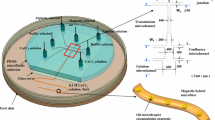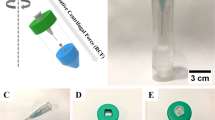Abstract
Recently, microbead generation and microencapsulation of cells using microfluidic technology have been actively pursued for various applications. However, most of the proposed systems are not only technically demanding, but might also be harmful to the encapsulated cells. To tackle these issues, this study reports a microfluidic alginate microbead generator consisting of a polydimethylsiloxane (PDMS) microfluidic chip and an integrated quartz microcapillary tube. The working principle is based on the use of a pulsed airflow to segment a continuous alginate suspension flow to form suspension fragments in a microchannel and then alginate microbeads when they were delivered out the microfluidic system to a sterile calcium chloride solution through a microcapillary tube. In this study, the alginate suspension fragments with varied sizes in the microchannel can be generated either by modulating the alginate suspension flow rate or the pulsation frequency of airflow injection. By fine tuning the size of them, the alginate microbeads can be generated in a size-controllable manner. Results showed that alginate microbeads with the size ranging from 150 to 370 μm in diameter can be generated at the suspension flow rate and airflow injection frequency ranges of 2–4 μl/min and 0.6–35 Hz, respectively. Besides, the alginate microbeads generated by the system were tested with excellent size uniformity (CV: 3.1–5.1%). Moreover, its application for the microencapsulation of chondrocytes in alginate microbeads was also demonstrated with high cell viability (96 ± 2%). As a whole, the proposed device has paved an alternative route to perform alginate microbead generation or microencapsulation of cells in a simple, continuous, controllable, uniform, cell friendly, and less contaminated manner.








Similar content being viewed by others
References
Abbah SA, Lu WW, Chan D, Cheung KMC, Liu WG, Zhao F, Li ZY, Leong JCY, Luk KDK (2006) In vitro evaluation of alginate encapsulated adipose-tissue stromal cells for use as injectable bone graft substitute. Biochem Biophys Res Commun 347:185–191
Al-Rubeai M, Singh RP, Goldman MH, Emery AN (1995) Death mechanisms of animal cells in conditions of intensive agitation. Biotechnol Bioeng 45:463–472
Cai X, Lin Y, Ou G, Luo E, Man Y, Yuan Q, Gong P (2007) Ectopic osteogenesis and chondrogenesis of bone marrow stromal stem cells in alginate system. Cell Biol Int 31:776–783
Choi CH, Jung JH, Rhee YW, Kim DP, Shim SE, Lee CS (2007) Generation of monodisperse alginate microspheres and in situ encapsulation of cells in microfluidic device. Biomed Microdevices 9:855–862
Christopher GF, Anna SL (2007) Microfluidic methods for generating continuous droplet streams. J Phys D Appl Phys 40:R319–R336
Chung C, Mesa J, Miller GJ, Randolph MA, Gill TJ, Burdick JA (2006) Effects of articular chondrocyte expansion on neocartilage formation in photocrosslinked hyaluronic acid networks. Tissue Eng 12:2665–2673
Clausell-Tormos J, Lieber D, Baret JC, El-Harrak A, Miller OJ, Frenz L, Blouwolff J, Humphry KJ, Koster S, Duan H, Holtze C, Weitz DA, Griffths AD, Merten CA (2008) Droplet-based microfluidic platforms for the encapsulation and screening of mammalian cells and multicellular organisms. Chem Biol 15:427–437
Dvir-Ginzberg M, Konson A, Cohen S, Agbaria R (2007) Entrapment of retroviral vector producer cells in three-dimensional alginate scaffolds for potential use in cancer gene therapy. J Biomed Mater Res B Appl Biomater 80:59–66
Elliott RB, Escobar L, Tan PLJ, Garkavenko O, Calafiore R, Basta P, Vasconcellos AV, Emerich DF, Thanos C, Bambra C (2005) Intraperitoneal alginate-encapsulated neonatal porcine islets in a placebo-controlled study with 16 diabetic cynomolgus primates. Transplant Proc 37:3505–3508
Emerich DF, Thanos CG, Goddard M, Skinner SJM, Geany MS, Bell WJ, Bintz B, Schneider P, Chu Y, Babu RS, Borlongan CV, Boekelheide K, Hall S, Bryant B, Kordower JH (2006) Extensive neuroprotection by choroid plexus transplants in excitotoxin lesioned monkeys. Neurobiol Dis 23:471–480
Gaver D, Kute S (1998) Theoretical model study of the influence of fluid stresses on a cell adhering to a microchannel wall. Biophys J 75:721–733
Gunther A, Khan SA, Thalmann M, Trachsel F, Jensen KF (2004) Transport and reaction in microscale segmented gas–liquid flow. Lab Chip 4:278–286
Huang KS, Liu MK, Wu CH, Yen YT, Lin YC (2007) Calcium alginate microcapsule generation on a microfluidic system fabricated using the optical disk process. J Micromech Microeng 17:1428–1434
Huang SB, Wu MH, Cui ZF, Cui Z, Lee GB (2008) A membrane-based serpentine-shape pneumatic micropump with pumping performance modulated by fluidic resistance. J Micromech Microeng 18:045008
Jork A, Thurmer F, Cramer H, Zimmermann G, Gessner P, Hamel K, Hofmann G, Kuttler B, Hahn HJ, Josimovic-Alasevic O, Fritsch KG, Zimmermann U (2002) Biocompatible alginate from freshly collected laminaria pallida for implantation. Appl Microbiol Biotechnol 53:224–229
Kaigler D, Krebsbach PH, Wang Z, West ER, Horger K, Mooney DJ (2006) Transplanted endothelial cells enhance orthotopic bone regeneration. J Dent Res 85:633–637
Klock G, Pfeffermann A, Ryser C, Grohn P, Kuttler B, Hahn HJ, Zimmermann U (1997) Biocompatibility of mannuronic acid-rich alginates. Biomaterials 18:707–713
Koster S, Angile FE, Duan H, Agresti JJ, Wintner A, Schmitz C, Rowat AC, Merten CA, Pisignnano D, Griffiths AD, Weitz DA (2008) Drop-based microfluidic devices for encapsulation of single cells. Lab Chip 8:1110–1115
Lin YH, Chen CT, Hung LLH, Lee GB (2007) Multiple-channel emulsion chips utilizing pneumatic choppers for biotechnology applications. Biomed Microdevices 9:833–843
Liu VA, Bhatia SN (2002) Three-dimensional photopatterning of hydrogels containing living cells. Biomed Microdevices 4:257–266
Liu K, Ding HJ, Liu J, Chen Y, Zhao XZ (2006) Shape-controlled production of biodegradable calcium alginate gel microparticles using a novel microfluidic device. Langmuir 22:9453–9457
Morimoto Y, Tan WH, Takeuchi S (2009) Three-dimensional axisymmetric flow-focusing device using stereolithography. Biomed Microdevices 11:369–377
Murua A, Portero A, Orive G, Hernandez RM, Castro MD, Pedraz JL (2008) Cell microencapsulation technology: towards clinical application. J Control Release 132:76–83
Schneider S, Feilen PJ, Brunnenmeier F, Minnemann T, Zimmermann H, Zimmermann U, Weber MM (2005) Long-term graft function of adult rat and human islets encapsulated in novel alginate-based microcapsules after transplantation in immunocompetent diabetic mice. Diabetes 54:687–693
Shintaku H, Kuwabara T, Kawano S, Suzuki T, Kanno I, Kotera H (2007) Micro cell encapsulation and its hydrogel-beads production using microfluidic device. Microsyst Technol 13:951–958
Song H, Bringer MR, Tice JD, Gerdts CJ, Ismagilov RF (2003) Experimental test of scaling of mixing by chaotic advection in droplets moving through microfluidic channels. Appl Phys Lett 83:4664–4666
Srinivasan V, Pamula VK, Fair RB (2004) An integrated digital microfluidic lab-on-a-chip for clinical diagnostics on human physiological fluids. Lab Chip 4:310–315
Stathopoulos NA, Hellums JD (2004) Shear stress effects on human embryonic kidney cells in vitro. Biotechnol Bioeng 27:1021–1026
Sugihara-Seki M (2000) Flow around cells adhered to a microvessel wall I. Fluid stresses and forces acting on the cells. Biorheology 37:341–359
Sugihara-Seki M (2001) Flow around cells adhered to a microvessel wall II. Comparison to flow around adherent cells in channel flow. Biorheology 38:3–13
Sugiura S, Oda T, Aoyagi Y, Matsuo R, Enomoto T, Matsumoto K, Nakamura T, Satake M, Ochiai A, Ohkohchi N, Nakajima M (2007) Microfabricated airflow nozzle for microencapsulation of living cells into 150 micrometers microcapsules. Biomed Microdevices 9:91–99
Tan WH, Takeuchi S (2007) Monodisperse alginate hydrogel microbeads for cell encapsulation. Adv Mater 19:2696–2701
Teh SY, Lin R, Hung LS, Lee AP (2008) Droplet microfluidics. Lab Chip 8:198–220
Wu MH, Urban JPG, Cui Z, Cui ZF (2006) Development of PDMS microbioreactor with well-defined and homogenous culture environment for chondrocyte 3-D culture. Biomed Microdevices 8:331–340
Wu MH, Urban JPG, Cui ZF, Cui Z, Xu X (2007) Effect of extracellular pH on matrix synthesis by chondrocytes in 3D agarose gel. Biotechnol Prog 23:430–434
Wu MH, Huang SB, Cui ZF, Cui Z, Lee GB (2008) Development of perfusion-based micro 3-D cell culture platform and its application for high throughput drug testing. Sens Actuators B 129:231–240
Xie J, Wang CH (2007) Electrospray in the dipping mode for cell microencapsulation. J Colloid Interface Sci 312:247–255
Xu X, Urban JPG, Tirlapur U, Wu MH, Cui Z, Cui ZF (2006) Influence of perfusion on metabolism and matrix production by bovine articular chondrocytes in hydrogel scaffolds. Biotechnol Bioeng 93:1103–1111
Xu J, Li S, Tan J, Luo G (2008) Controllable preparation of monodispersed calcium alginate microbeads in a novel microfluidic system. Chem Eng Technol 31:1223–1226
Yang CH, Huang KS, Chang JY (2007) Manufacturing monodisperse chitosan microparticles containing ampicillin using a microchannel chip. Biomed Microdevices 9:253–259
Yeh J, Lin Y, Karp JM, Gantz J, Chandawarkar A, Eng G (2006) Micromolding of shape-controlled, harvestable cell-laden hydrogels. Biomaterials 27:5391–5398
Acknowledgment
This project is sponsored by the National Science Council (NSC) in Taiwan (NSC 98-2221-E-182-008).
Author information
Authors and Affiliations
Corresponding author
Rights and permissions
About this article
Cite this article
Wu, MH., Pan, WC. Development of microfluidic alginate microbead generator tunable by pulsed airflow injection for the microencapsulation of cells. Microfluid Nanofluid 8, 823–835 (2010). https://doi.org/10.1007/s10404-009-0522-6
Received:
Accepted:
Published:
Issue Date:
DOI: https://doi.org/10.1007/s10404-009-0522-6




